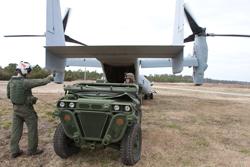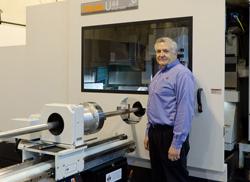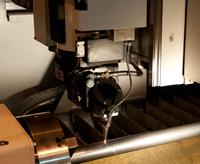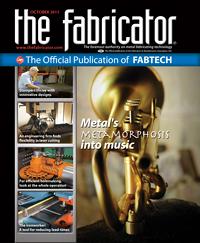Editor-in-Chief
- FMA
- The Fabricator
- FABTECH
- Canadian Metalworking
Categories
- Additive Manufacturing
- Aluminum Welding
- Arc Welding
- Assembly and Joining
- Automation and Robotics
- Bending and Forming
- Consumables
- Cutting and Weld Prep
- Electric Vehicles
- En Español
- Finishing
- Hydroforming
- Laser Cutting
- Laser Welding
- Machining
- Manufacturing Software
- Materials Handling
- Metals/Materials
- Oxyfuel Cutting
- Plasma Cutting
- Power Tools
- Punching and Other Holemaking
- Roll Forming
- Safety
- Sawing
- Shearing
- Shop Management
- Testing and Measuring
- Tube and Pipe Fabrication
- Tube and Pipe Production
- Waterjet Cutting
Industry Directory
Webcasts
Podcasts
FAB 40
Advertise
Subscribe
Account Login
Search
Engineering firm enters the 3-D world of laser cutting
Systems Engineering & Manufacturing now makes its innovative designs a reality
- By Dan Davis
- October 20, 2011
- Article
- Laser Cutting

Figure 1: What began as a simple redesign job for a component on the Expeditionary Fire Support System for the U.S. Marine Corps has become a full-scale fabrication effort to produce several parts for the vehicle. Photo courtesy of U.S. Marine Corps.
Many fabricating operations begin life producing parts to print. Systems Engineering & Manufacturing (SE&M), Forest, Va., is not that type of shop.
The company began life advising a customer in the defense industry how to make its metal parts more efficiently, and that design expertise has become SE&M’s calling card. “[Design expertise] is the only way to stand out,” said Bob Schmidt, SE&M president. “That‘s why our customers come to us—for solutions, not to make parts.”
To help deliver those solutions, however, SE&M needed a flexible tool capable of working with a variety of raw materials, from flat sheet metal to already-formed tube stock. The company purchased a laser cutting machine capable of 2-D processing; 3-D cutting of preformed shapes; and 3-D rotary cutting of tube, pipe, and structural shapes.
Fabricating Comes Back In-house
SE&M came into being in 2000 when a local manufacturer was in the process of shutting its doors, and a group of employees took over an important product line. The failing company’s customers were pleased to have an experienced team step in and maintain the supply of metal parts, so this new engineering house with light fabrication capabilities was formally in business.
“From the beginning we were about offering very comprehensive problem-solving to customers,” Schmidt said. “Initially this involved completing engineering and some fabricating in-house but outsourcing quite a bit of nondesign work to local shops.”
That approach changed in 2006 after a simple phone call. An engineering acquaintance from the defense industry called Schmidt and asked if his company could help with a job related to the Expeditionary Fire Support System (EFSS), a mobile artillery system for the U.S. Marine Corps comprised of two light-armored vehicles: one that tows a 120-mm rifled mortar and the other that tows an ammunition trailer (see sidebar “Artillery Designed for Mobility”). The vehicles needed a redesigned steering knuckle, a key connecting part in the steering assembly that allows the front wheel to pivot.
SE&M took the job. The company’s engineers redesigned the casting, coordinated its manufacturing, guided it through secondary machining processes, and delivered the new steering knuckles in four weeks. Knowing the right people allowed his company to turn around the job so quickly, Schmidt said.
That turned out to be the first of many jobs on the EFSS (see Figure 1).
“We did that, and then they asked, ‘Can you do this? Can you do this? Can you do the whole thing?’” Schmidt said.
Today the company produces every fabricated component on the EFSS (see Figure 2). That includes parts made from steel tubing of varying wall thicknesses and many types of flat stock.

Figure 2: The EFSS subframe contains plenty of tubing that had been outsourced for laser cutting until SE&M invested in its own laser cutting machine. Photo courtesy of Mazak Optonics Corp.
Schmidt had been looking at equipment that might be able to help SE&M handle these various fabricating chores. He knew about the capabilities of tube laser cutting machines because his subcontractor had one, but the equipment would not have been able to cut preformed tubes. A 3-D laser was necessary for that chore.
The Right Tool for the Right Job
As the amount of work on the EFSS grew, the need for a laser cutting center became evident. SE&M had been processing many of the parts through its machine shop, using sawing and milling centers predominantly to prepare components for welding processes. Running these jobs across multiple stations had created work flow and scheduling challenges.
In mid-2010 SE&M purchased a Mazak Optonics SpaceGear U44 (see Figure 3) to handle the 2-D and 3-D jobs. It can cut and mark tube in preparation for welding or other operations. It processes flat sheet consistently. With the six-axis cutting capability, it can cut tube that’s already been bent.
“And because it allows us to pass parts underneath the head, we can cut any length of component that we need,” Schmidt said.
The fabricator produces a large majority of the 544 components found on the EFSS’ body weldment on its new laser cutting machine. Most of the parts are completed once they are unloaded from the laser, but a small percentage still require secondary finishing operations. However, it’s nowhere near the number that had the aisles jammed up with work-in-process moving from one station to another.
In addition to streamlining work flow, the laser cutting machine also has helped to increase production efficiency of the EFSS. The laser can produce parts within strict tolerances, and the machine programmer can instruct the laser to mark for locating pins and bend points—all of which has led to better component fit-up and reduced rework (see Figure 4).
Always Room for Improvement
Of course, being a fabricator with so much mechanical expertise, SE&M didn’t waste too much time seeking out a way to increase the flexibility of its new machine. The company’s engineers decided to build their own custom bar feeder.
Several options were available from other technology integrators, but the SE&M team couldn’t find one that provided a second chuck that would operate in tandem with the chuck in the machine. The option of working with two chucks would allow SE&M to cut especially long components because tension and potential twisting would be eliminated from the raw material.
“We’ve cut up to 12-in. pipe on the machine using the bar feeder,” Schmidt said. “You have that type of work at one end of the spectrum. At the other, we did a strainer for the EFSS that was 3.25 in. in diameter and contained 3,200 holes.”
The tweaks didn’t end there. SE&M also developed a series of tube holders that operators can put through the chucks to eliminate the potential for drops during laser cutting.

Figure 3: Laser cutting allows SE&M to hold extremely tight tolerances on the parts it fabricates for the EFSS. “When we’re done, we can’t have an extra one-eighth inch anywhere on the vehicle,” SE&M’s Bob Schmidt said.
“It’s definitely kept us busy, but it’s also been very good for us,” Schmidt said.
In the meantime, SE&M is seeking out other customers to take advantage of its engineering expertise and laser cutting capabilities. Sometimes a job might call for a simple $20 component for a small shop down the street. Other times a job, such as designing, building, and installing an automation system for a bottling plant, requires all aspects of the business to step up its game.
No matter what the scope of the job, however, SE&M now has the flexible fabricating tool to adapt to and overcome any challenge thrown its way.
Artillery Designed for Mobility
The Expeditionary Fire Support System (EFSS) provides the U.S. Marine Corps with a mobile artillery system that can be maneuvered quickly on the battlefield. Marines use the weapon to maintain consistent artillery pressure on the enemy while simultaneously making it difficult for the enemy to return fire accurately. Because of the weapon’s light and easy-to-move design, Marines can move quickly from one spot to another between firing rounds. The EFSS’ mortar can target enemy troops and vehicles from a distance of up to five miles away.
The EFSS also can be moved easily in and out of combat zones. Because of its compact design, the EFSS can be transported in the back of a Sikorsky CH-53E Super Stallion helicopter or a Boeing V-22 Osprey tiltrotor aircraft.
About the Author

Dan Davis
2135 Point Blvd.
Elgin, IL 60123
815-227-8281
Dan Davis is editor-in-chief of The Fabricator, the industry's most widely circulated metal fabricating magazine, and its sister publications, The Tube & Pipe Journal and The Welder. He has been with the publications since April 2002.
Related Companies
subscribe now

The Fabricator is North America's leading magazine for the metal forming and fabricating industry. The magazine delivers the news, technical articles, and case histories that enable fabricators to do their jobs more efficiently. The Fabricator has served the industry since 1970.
start your free subscription- Stay connected from anywhere

Easily access valuable industry resources now with full access to the digital edition of The Fabricator.

Easily access valuable industry resources now with full access to the digital edition of The Welder.

Easily access valuable industry resources now with full access to the digital edition of The Tube and Pipe Journal.
- Podcasting
- Podcast:
- The Fabricator Podcast
- Published:
- 04/16/2024
- Running Time:
- 63:29
In this episode of The Fabricator Podcast, Caleb Chamberlain, co-founder and CEO of OSH Cut, discusses his company’s...
- Industry Events
16th Annual Safety Conference
- April 30 - May 1, 2024
- Elgin,
Pipe and Tube Conference
- May 21 - 22, 2024
- Omaha, NE
World-Class Roll Forming Workshop
- June 5 - 6, 2024
- Louisville, KY
Advanced Laser Application Workshop
- June 25 - 27, 2024
- Novi, MI
































